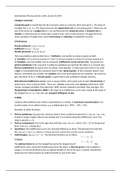Samenvatting
Microeconomics for EOR Summary
- Vak
- Microeconomics
- Instelling
- Rijksuniversiteit Groningen (RuG)
This is a summary of Intermediate Microeconomics with calclus first edition for EOR students. This summary covers the essentials of Chapters: 2-6,8,9,14-16,19-26,28,29,32. It may have a couple references to the book itself, but without the book the summary will be enough. It covers the definitions ...
[Meer zien]





